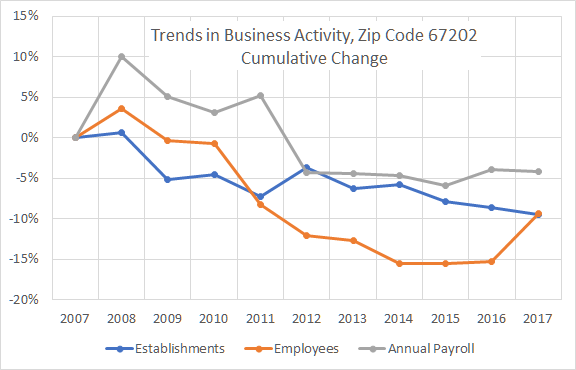New Census Bureau data shows the population growing in downtown Wichita.
Data released today by the United States Census Bureau shows the estimated population for zip code 67202 in 2018 was 1,671, an increase of 73 from the prior year.
Zip code 67202 is greater downtown Wichita, from the Arkansas River east to Washington, and Kellogg north to Central, roughly.
The source of this data is U.S. Census Bureau, 2014-2018 American Community Survey 5-Year Estimates. This means the data is not the Bureau’s estimate of the population in 2018. For areas of population less than 65,000, the Bureau does not provide one-year estimates. Instead, the five-year estimates use data gathered over a longer time period in order to provide greater accuracy. The 90 percent confidence interval for the 2018 estimate is plus or minus 214 persons.
The Bureau cautions that the five-year estimates should not be used as the population of the year in the midpoint of the five-year period: “Therefore, ACS estimates based on data collected from 2011–2015 should not be labeled ‘2013,’ even though that is the midpoint of the 5-year period.” (See below for more about these data.)
Further, the Bureau issues this advice: “However, in areas experiencing major changes over a given time period, the multiyear estimates may be quite different from the single-year estimates for any of the individual years.” Downtown Wichita, I believe, qualifies as an area “experiencing major changes.” The five-year estimates must be considered in light of this advice.
Still, as shown in the nearby table and charts, the ACS numbers are far below the population reported by the downtown Wichita development agency Downtown Wichita. See my article Downtown Wichita population for more about this topic.


Following, excerpts from the Census Bureau publication Understanding and Using American Community Survey Data: What All Data Users Need to Know.
Understanding Period Estimates
Single-year and multiyear estimates from the ACS are all “period” estimates derived from a sample collected over a period of time, as opposed to “point-in-time” estimates such as those from past decennial censuses. For example, the 2000 Census “long form” sampled the resident U.S. population as of April 1, 2000.
While an ACS 1-year estimate includes information collected over a 12-month period, an ACS 5-year estimateincludes data collected over a 60-month period.
In the case of ACS 1-year estimates, the period is the calendar year (e.g., the 2015 ACS covers the period from January 2015 through December 2015). In the case of ACS multiyear estimates, the period is 5 calendar years (e.g., the 2011–2015 ACS estimates cover the period from January 2011 through December 2015). Therefore, ACS estimates based on data collected from 2011–2015 should not be labeled “2013,” even though that is the midpoint of the 5-year period.
Multiyear estimates should be labeled to indicate clearly the full period of time (e.g., “The child poverty rate in 2011–2015 was X percent.”). They do not describe any specific day, month, or year within that time period.
Multiyear estimates require some considerations that single-year estimates do not. For example, multiyear estimates released in consecutive years consist mostly of overlapping years and shared data.
The primary advantage of using multiyear estimates is the increased statistical reliability of the data compared with that of single-year estimates, particularly for small geographic areas and small population subgroups. Figure 3.2 shows the improved precision of an ACS 5-year estimate, compared with a 1-year estimate, for child poverty statistics in Rice County, Minnesota—a county with about 65,000 residents in 2015. The lines above and below the point estimates represent the confidence intervals, or ranges of uncertainty, around each estimate. The confidence interval for the 1-year child poverty estimate ranges from 1.4 percent to 9.4 percent (8 percentage points) while the interval for the 5-year estimate is narrower, ranging from 12.8 percent to 19.2 percent (6 percentage points). (Refer to the section on “Understanding Error and Determining Statistical Significance” for a detailed explanation of uncertainty in ACS data.)
Deciding Which ACS Estimate to Use
For data users interested in obtaining detailed ACS data for small geographic areas (areas with fewer than 65,000 residents), ACS 5-year estimates are the only option.
The 5-year estimates for an area have larger samples and smaller margins of error than the 1-year estimates. However, they are less current because the larger samples include data that were collected in earlier years. The main advantage of using multiyear estimates is the increased statistical reliability for smaller geographic areas and small population groups.
However, in areas experiencing major changes over a given time period, the multiyear estimates may be quite different from the single-year estimates for any of the individual years. The single year and multiyear estimates will not be the same because they are based on data from two different time periods.



































